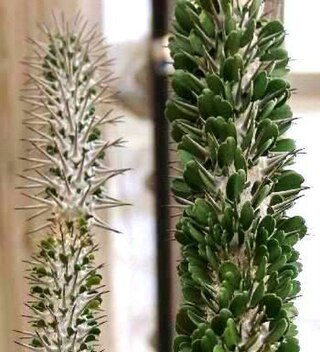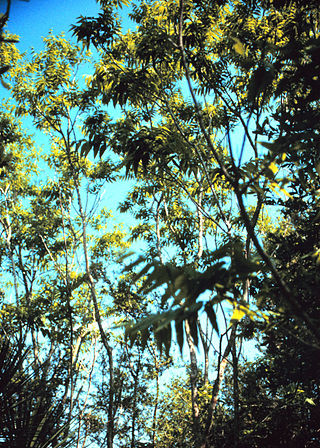Tina is a genus of tropical trees in the family Sapindaceae, native to the eastern coast of Madagascar.

The Sapotaceae are a family of flowering plants belonging to the order Ericales. The family includes about 800 species of evergreen trees and shrubs in around 65 genera. Their distribution is pantropical.

Didiereaceae is a family of flowering plants found in continental Africa and Madagascar. It contains 20 species classified in three subfamilies and six genera. Species of the family are succulent plants, growing in sub-arid to arid habitats. Several are known as ornamental plants in specialist succulent collections. The subfamily Didiereoideae is endemic to the southwest of Madagascar, where the species are characteristic elements of the spiny thickets.

Sapindus is a genus of about thirteen species of shrubs and small trees in the lychee family, Sapindaceae and tribe Sapindeae. It is native to warm temperate to tropical regions of the world. The genus includes both deciduous and evergreen species. Members of the genus are commonly known as soapberries or soapnuts because the fruit pulp is used to make soap. The generic name is derived from the Latin words sapo, meaning "soap", and indicus, meaning "of India".

Cupaniopsis is a genus of about 45 species of flowering plants in the family, Sapindaceae and are native to Fiji, Indonesia, New Caledonia, New Guinea, the Solomon Islands Vanuatu, Samoa, Torres Strait Islands, Micronesia and Australia. Plants in the genus Cupaniopsis are trees with paripinnate with small, regular flowers with 5 sepals and petals with 6 to 10 stamens and the fruit a capsule.

Harpullia is a genus of about 27 species of small to medium-sized rainforest trees from the family Sapindaceae. They have a wide distribution ranging from India eastwards through Malesia, Papuasia and Australasia to the Pacific Islands. They grow naturally usually in or on the margins of rainforests or associated vegetation. Plants in the genus Harpullia are usually dioecious shrubs or trees covered with simple or star-shaped hairs. The leaves are paripinnate and the flowers are usually arranged in leaf axils, usually with 5 petals, 5 to 8 stamens and a 2-locular ovary. The fruit is a 2-lobed capsule.

Allophylus is a genus within the plant family Sapindaceae. It includes 211 species with a pantropical distribution.
Camptolepis is a genus of plant in family Sapindaceae. It contains the following species :

Vepris is a genus of plant in family Rutaceae. It comprises around 90 species, mainly from tropical Africa, Madagascar and the Mascarene Islands and at a lesser extent Arabia and India.

Ludwig Adolph Timotheus Radlkofer, was a Bavarian taxonomist and botanist.

Lepisanthes is a genus of 31 species of trees or shrubs native to tropical Africa, south and southeast Asia, Australia, and Madagascar.

Doratoxylon is a genus of flowering plants in the family Sapindaceae.

Sapindoideae is a subfamily of flowering plants in the soapberry family, Sapindaceae. It includes a number of fruit trees, including lychees, longans, rambutans, and quenepas.
Zanha is a small genus of plants in the family Sapindaceae that are native to Africa.
Conchopetalum is a genus of flowering plants belonging to the family Sapindaceae.

Deinbollia is a genus of flowering plants belonging to the family Sapindaceae.
Molinaea is a genus of flowering plants belonging to the family Sapindaceae.

Macphersonia is a genus of flowering plants belonging to the family Sapindaceae.












